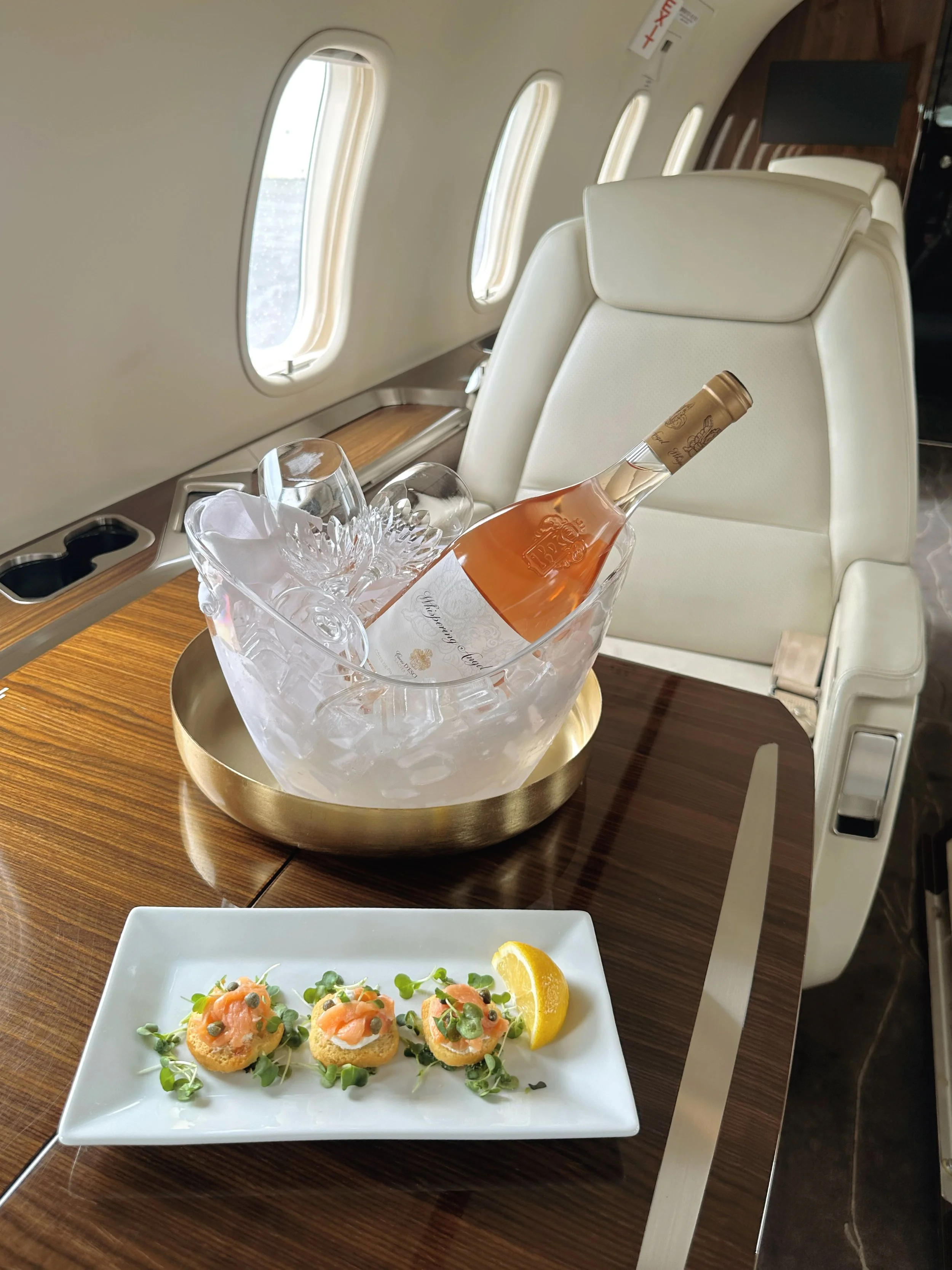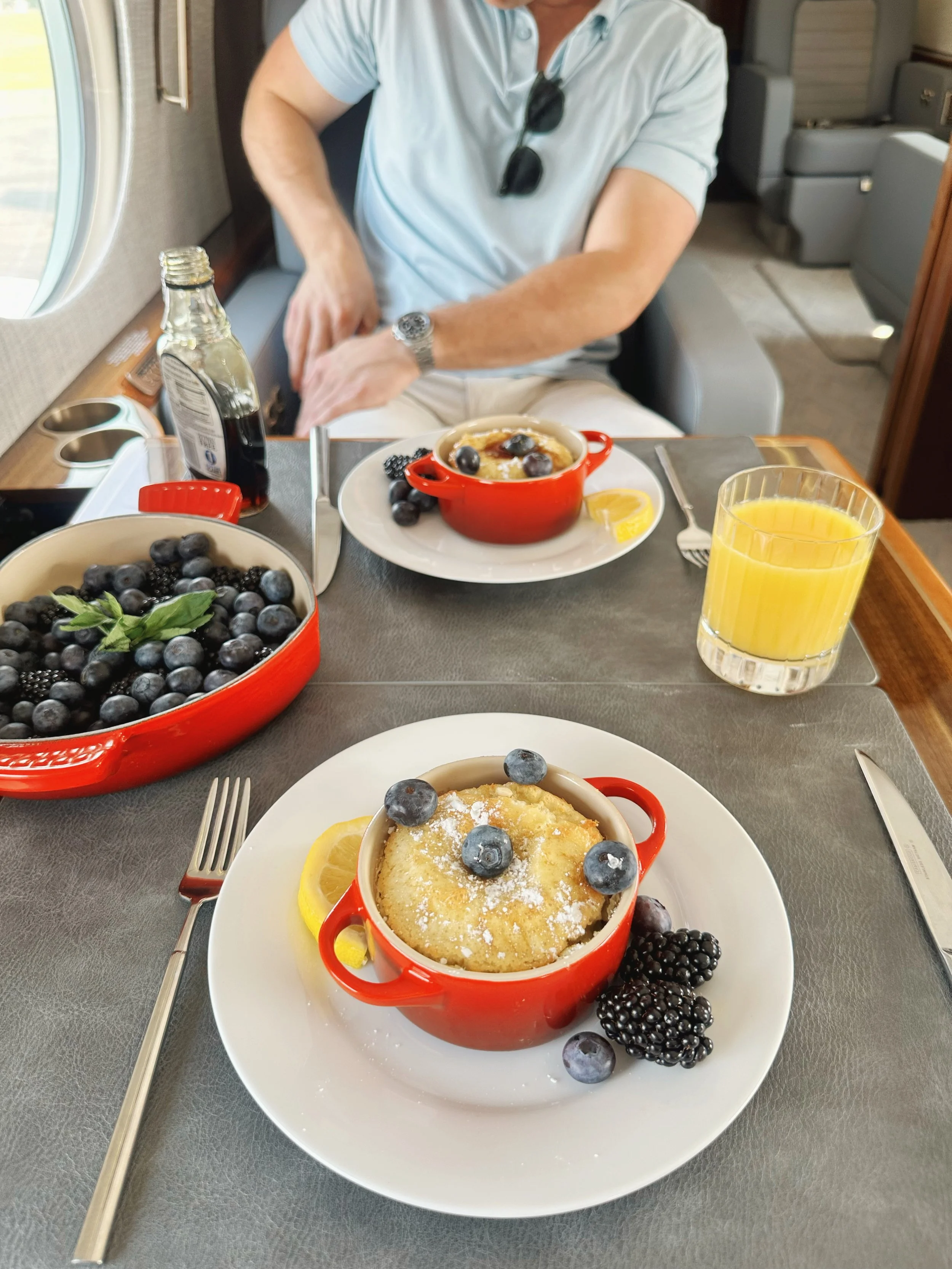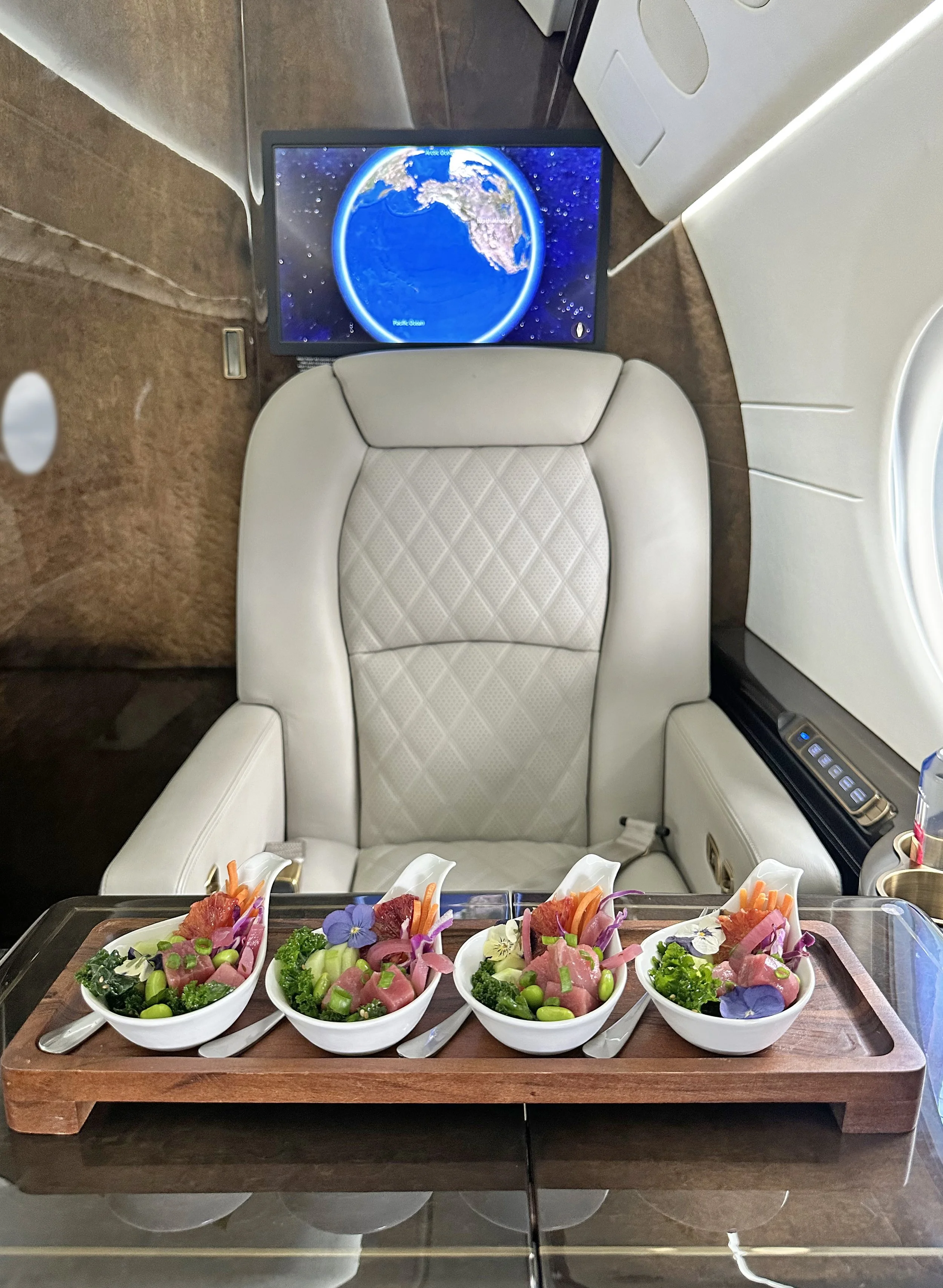Private Jet Catering: At Your Wish
/Private jet travel offers many advantages over scheduled airlines. No hours-in-advance arrivals, no long security lines, no 5 a.m. departures (unless that works best for you), no kids kicking your cramped seat, etc. It’s a more personalized, convenient and pleasant experience, even compared to first-class airline sections.
However, those who travel from business airports rather than commercial do often experience one disadvantage – the breadth of food options on the ground. Commercial airports – many of which are undergoing expansions as part of renovations intended to address aging infrastructure -- typically have a variety of food options ranging from very fast to sit-down. While not every commercial airport has a true gourmet restaurant, enough do that Food & Wine magazine recently declared, “airport dining in America has finally achieved the culinary status that travelers have craved.”
Seafood Tower. Photo courtesy of Executive Fliteways
Business airports, on the other hand, are much more hit and miss. Some well-traveled sites are able to offer lavish food options – those flying out of Geneva, Dubai or Teterboro, New Jersey can satisfy a lot of cravings. But many other business airports provide more limited dining options that may or may not be available if safety concerns delay your flight until later.
Fortunately for private jet travelers, the ground is not the only place where sustenance can be enjoyed. If you’re traveling via private jet, your options to quench your hunger and thirst while soaring through the skies can be many and varied. If you’d like to learn more about your private jet catering options, read on.
Food Over Time
The history of food in flight goes back more than a century. While zeppelin “airships” offered meals and drinks to their passengers early in the 1900s, the first known airline meal was served in 1919 on a flight between London and Paris, with boxed lunches offered for sale. In 1927, a French Air Union flight offered the first full-service meal that included lobster salad, cheese and fruit, ice cream and other courses, with beverages such as champagne and mineral water to wash everything down. The first hot meal in the air was achieved in 1928, with a Lufthansa flight from Berlin to Paris featuring a full galley kitchen (albeit for only 15 passengers).
As frozen food technology improved in the 1940s, more commercial airlines were able to provide actual meals to passengers. Evolution of on-board kitchens in later decades allowed for food options to expand further. By the 1970s, air travelers typically expected to have full meals on almost all flights outside of short hops
Oysters. Photo Courtesy of Executive Fliteways
Smoked salmon Canapes. Photo courtesy of Executive Fliteways
A change was coming, though, from an unexpected source. In 1978, the Airline Deregulation Act prohibited the U.S. federal government from controlling airline fares, routes and market entry – a dramatic change from the status quo. When airfares were set by regulators, airlines focused on catering options as a major competitive differentiator. Once airlines were able to compete on ticket prices instead, food became much less important.
Lower ticket prices opened up air travel to more passengers but put pressure on bottom lines. Perhaps the most famous illustration of the new approach toward in-flight food came from American Airlines in 1987, when the company claimed the elimination of a single olive from each salad served to first-class customers saved $40,000 per year.
Baby Dutch Pancakes. Photo courtesy of Executive Fliteways
Creme Brulee. Photo courtesy of Executive Fliteways
The pressure on the airline industry after terrorist attacks on September 11, 2001 accelerated a shift away from in-flight meals as part of the economy class ticket price. Today, U.S. airlines often look to food as an additional revenue source, selling snack boxes and alcoholic drinks to help economy-class passengers endure their journey.
First-class and business-class passengers, of course, still have many more food and beverage options offered as part of their base service. Private jet travelers, however, are able to personalize their culinary opportunities much more specifically than even those choosing the most high-end scheduled airlines.
Save the Steak Frites for Later
Those looking for a gourmet experience in the sky will have to accept some limitations. For example, given safety concerns, even the highest-end private jets will not have the same type of cooking facilities in a restaurant kitchen. Convection ovens and microwaves are the most common cooking options, and light and midsized jets may not have any cooking elements at all. “Any sort of heat source is a potential problem on an aircraft,” says charter aviation consultant Paul Travis. “Food tends to be created in specialized facilities and then re-heated.”
Charter aviation company Magellan Jets has a list of foods to avoid while flying private, including steak and lamb chops – “best enjoyed fresh off the grill, these meats can overcook when reheated.” Fried foods can also be a bad idea, given how their quality tends to deteriorate after reheating. While flight attendants in private jets are expected to show the range of their creativity in preparing culinary delights, even the most talented can’t overcome certain food preparation realities.
On the other hand, mixed selections of food such as charcuterie boards or cheese trays are well-suited to in-air cuisine. Salads also tend to travel well, and chicken and fish entrees can re-heat without sacrificing taste. “Some of our most popular options include grilled chicken and quinoa salad, seared ahi tuna with avocado and sesame dressing and chopped Greek salad with shrimp or chicken,” says Kristen Steinhardt, executive VP of marketing for charter operator Executive Fliteways.
For Your Health
Like almost everything else, catering for private jet travel has been affected by COVID-19. Though charter flights dropped dramatically year-over-year in 2020 over 2019 as the world struggled to deal with quarantines and lockdowns, private jet travel started climbing back up in 2021, as new customers freed by the move to remote work were drawn by the appeal of avoiding germs of the masses. In 2024, there were 30% more business jet departures than in 2019 worldwide, with an increase of 27% over the same time period in North America specifically.
These new customers are taking their own approach to food in the air. “As more clients turned to private charters for safety and convenience, there has been a noticeable move toward health-conscious choices. Passengers are increasingly requesting light, nutritious bites and immune-boosting beverages, reflecting a stronger focus on wellness while traveling,” says Steinhardt. “Many want to arrive at their destination feeling refreshed and energized, so menus often include fresh juices, organic snacks and clean, balanced meals.”
Watermelon salad. Photo courtesy of Executive Fliteways
Seabass Ceviche. Photo courtesy of Executive Fliteways
Pandemic effects are also showing up on the catering supply side. The food industry has been particularly affected by staffing shortages, and food costs have been a particular area of inflation during the last few years. “Some caterers require more advance notice, and there have been more last-minute cancellations,” Steinhardt recounts.
How Much Is That Sandwich?!?
There are regional variations in how catering costs are handled for private jet travel. “Almost always in the U.S., catering is not included in the price,” says private aviation consultant Paul Travis. “In Europe, it’s included in the charter price and operators put in an element in the charter rate to cover it.”
Those costs can be difficult to predict. While the precise price tag will depend on factors including exactly what foods you crave and how many people are flying, estimates for catering start at around $230 to $2,000 per leg.
“Service charges” can drive prices up even more. Several months ago, Daniel Harris, managing partner of aviation investment and consulting firm Ironbird Partners, polled his followers on LinkedIn as to how much they thought a sandwich box cost him for a charter flight out of Jackson Hole, Wyoming: $110, $148, $177 or $298. Only 27% of respondents guessed correctly -- $177(.05), with the actual sandwich portion coming to “only” $77.05 before the service charge of $100. Others chimed in with receipts for $427 for fruit for six people and $373 for breakfast for three from other charter flights.
“A number of colleagues and I have commented that we’re in the wrong business -- executive jet catering seems to be where the money is,” Travis says. “However, that’s probably an unfair assessment of their business model. There’s an awful lot of overhead and expense involved.”
For those looking to hold down food and beverage costs, fixed-base operators (FBOs) can suggest local caterers who are less expensive. “Coordination with FBOs is usually smooth,” Steinhardt says. “They often provide ample fridge and freezer space to store perishable items overnight and are helpful in confirming catering deliveries and bringing food out to the aircraft upon request.”
Another possibility, though, is food sourced directly by your charter aviation provider. While some primarily offer pickups from fast-casual restaurants or Whole Foods, others are seeking to go the extra mile to make their cuisine offerings a competitive advantage.
Poke Bowls. Photo Courtesy of Executive Fliteways
Towering Delectables
Clients of Executive Fliteways recently benefited from some leisure activities of a company executive. “Our boss came back from tuna fishing, and we filleted the fish to make poke bowls on a flight,” Steinhardt says. “This tuna never saw a grocery store – just the ocean and a Gulfstream.”
Other specialized offerings by Executive Fliteways include blue point local oysters with mignonette, watermelon feta pomegranate salad, plane-made seabass ceviche (fish chopped ahead of time and then marinated in lime juice on board) and smoked salmon canapés. For those looking to finish things off with a flourish, crème brulee baked on the ground can be caramelized with a blow torch in the air before serving. For breakfast, there are baby Dutch German pancakes with the batter blended before boarding and baked after takeoff.
“There’s been a rise in more visually creative catering. Instagram-worthy cocktails, beautifully plated canapés and elevated presentations are increasingly popular, especially for celebratory trips or content-driven travelers,” Steinhardt says. “Whether it’s a personalized amuse-bouche or a custom cocktail with a branded stir stick, clients appreciate the little details that make the experience feel special and unique.”
Food Ahead
The future of private jet catering is likely to include a focus on waste reduction. Many caterers, for example, are moving toward biodegradable packaging with items such as bamboo-based platters and containers, wraps and packaging. After decades of disposable preparation and serving materials in the air, there is a turn back toward china plates, actual glassware and reusable bakeware. “We encourage flight attendants to order ingredients in bulk and plate onboard whenever possible, helping to reduce the use of individually wrapped items,” Steinhardt shares.
However things evolve, flexibility and creativity will continue to be vital to private jet catering. Travis remembers the challenges involved in flying a film crew from Canada to Africa in a chartered 747 jet. “We spoke with the regular airline caterers in Quebec City and didn’t feel their food was up to the standard required, so we had to search for high-end restaurant food,” Travis remembers. “You’d get the catering, and it would take an hour or more to load because of the non-standard packaging.”
Ultimately, Travis’s team ensured that the actors and the crew members were satisfied. “We got it done, and the olives in particular were quite worth the effort,” Travis concludes.









